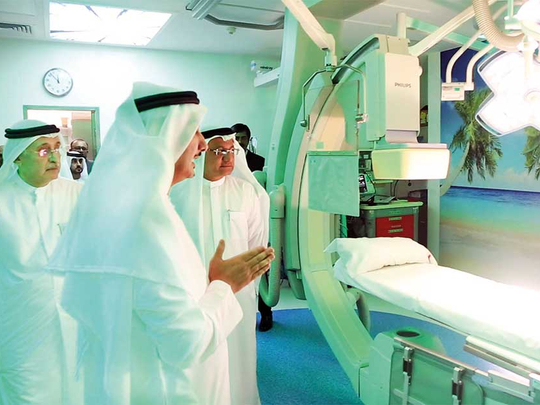
Dubai: Rashid Hospital has become the first health care facility in the Middle East to introduce a state-of-the-art catheterisation laboratory (cath lab), the Dubai Health Authority (DHA) announced on Saturday.
According to DHA, the highly specialised system has two procedure rooms, a Hybrid and a Biplane lab, that boast of cutting-edge features and have a calm and stimulating environment to ease patients’ anxiety.
Given the high volume of cardiovascular cases the hospital receives, the advanced lab will benefit a significant number of patients.
The cardiology department is the second busiest at the hospital after the Emergency and Trauma Centre.
patients underwent cath procedures at hospital in 2017
In 2017, more than 1,900 patients underwent cath procedures, including pacemaker installation, coronary angiogram, coronary angioplasty with stenting, and transcatheter aortic valve implantation (TAVI).
Globally, cardiovascular disease is the number one cause of death and, according to some studies, heart attacks take place approximately ten years earlier in the Middle East than in many western countries.
“Life-saving procedures are a priority and we will continue to invest in technology, manpower and management systems to provide the highest quality of care to our patients. The introduction of this technology will directly benefit patient outcomes and experience,” said Humaid Mohammad Obaid Al Qutami, director-general of DHA.
The Biplane cath lab is equipped with an electrophysiology system to do ablation procedures.
Dr Fahd Baslaib, CEO of Rashid Hospital and head of cardiology, said: “The hybrid catheterisation system combines both catheterisation and surgical procedures so that if there is an emergency we can immediately switch from the minimally invasive procedure to a surgical one in the same location almost immediately.
This saves time, which is critical in such cases, and ensures quicker patient recovery. Even in non-critical cases, the system is highly beneficial as we can perform different procedures one after the other. This eliminates the need to transfer patients, reduces the waiting time between two procedures and ensures quicker patient recovery.”
Dr Baslaib added that the cath lab uses 60 to 80 per cent lesser radiation without affecting the resolution of images, which is a major advantage.












